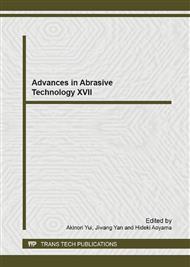[1]
T. Brockhoff and E. Brinksmeier, Grind-Hardening: A Comprehensive View, CIRP Annals - Manufacturing Technology, 48(1) (1999) 255-260.
DOI: 10.1016/s0007-8506(07)63178-3
Google Scholar
[2]
L.C. Zhang, Grinding-hardening of steel surfaces: a focus review, IJAT 1(1) (2007) 3-36.
Google Scholar
[3]
I. Zarudi and L.C. Zhang, Mechanical property improvement of quenchable steel by grinding, J. Mater. Sci. 37(18) (2002) 3935-3943.
Google Scholar
[4]
T. Nguyen, I. Zarudi and L.C. Zhang, Grinding-hardening with liquid nitrogen: Mechanisms and technology, Int. J. Mach. Tool Manu. 47(1) (2007) 97-106.
DOI: 10.1016/j.ijmachtools.2006.02.010
Google Scholar
[5]
B. Kolkwitz, T. Foeckerer, C. Heinzel, M.F. Zaeh and E. E. Brinksmeier, Experimental and Numerical Analysis of the Surface Integrity resulting from Outer-Diameter Grind-Hardening, Procedia Eng. 19 (2011) 222-227.
DOI: 10.1016/j.proeng.2011.11.104
Google Scholar
[6]
G.A. Hyatt, M. Mori, T. Foeckerer, M.F. Zaeh, N. Niemeyer and M. Duscha, Integration of heat treatment into the process chain of a mill turn centre by enabling external cylindrical grind-hardening, Prod. Eng. Res. Devel. 7 (2013) 571-584.
DOI: 10.1007/s11740-013-0465-3
Google Scholar
[7]
T. Nguyen and L.C. Zhang, Realisation of grinding-hardening in workpieces of curved surfaces-Part 1: Plunge cylindrical grinding, Int. J. Mach. Tool Manu. 51(4) (2011) 309-319.
DOI: 10.1016/j.ijmachtools.2010.12.006
Google Scholar
[8]
T. Nguyen and L.C. Zhang, Grinding-hardening using dry air and liquid nitrogen: prediction and verification of temperature fields and hardened layer thickness, Int. J. Mach. Tool Manu. 50(10) (2010) 901-910.
DOI: 10.1016/j.ijmachtools.2010.06.002
Google Scholar
[9]
L.C. Zhang, Solid Mechanics for Engineers, Palgrave / Macmillan, New York, (2001).
Google Scholar
[10]
W.C. Leslie, The Physical Metallurgy of Steels, McGraw Hill, New York, (1982).
Google Scholar
[11]
L.C. Zhang, T. Suto, H. Noguchi and T. Waida, An overview of applied mechanics in grinding, Manufacturing Review 5(4) (1992) 261-273.
Google Scholar
[12]
T. Reti, Residual stresses in carburized, carbonitrided, and case-hardened components, in Handbook of residual stresses and deformation of steel, G.E. Totten, M.A.H. Howes, and H. Inoue, Editors. 2002, ASM International, The Materials Information Society.
Google Scholar
[13]
W.K.C. Jones and P.J. Alberry, A model for stress accumulation in steels during welding. in Residual stresses in welded construction and their effects: an international conference (1977) London: The Welding Institute, Cambridge.
Google Scholar


